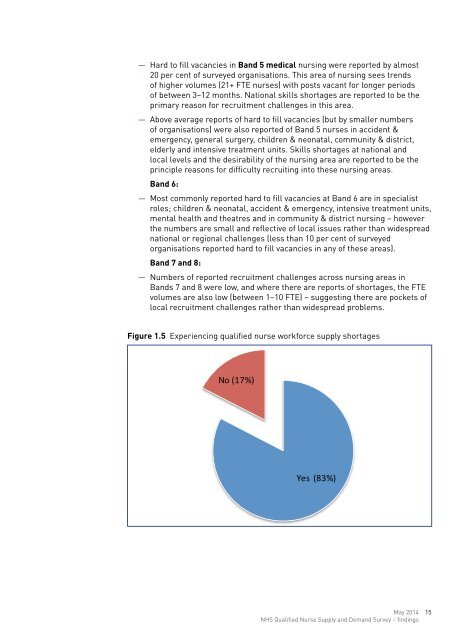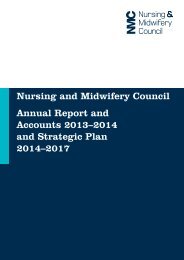NHS-qualified-nurse-supply-and-demand-survey-12-May1
NHS-qualified-nurse-supply-and-demand-survey-12-May1
NHS-qualified-nurse-supply-and-demand-survey-12-May1
- No tags were found...
You also want an ePaper? Increase the reach of your titles
YUMPU automatically turns print PDFs into web optimized ePapers that Google loves.
— Hard to fill vacancies in B<strong>and</strong> 5 medical nursing were reported by almost20 per cent of <strong>survey</strong>ed organisations. This area of nursing sees trendsof higher volumes (21+ FTE <strong>nurse</strong>s) with posts vacant for longer periodsof between 3–<strong>12</strong> months. National skills shortages are reported to be theprimary reason for recruitment challenges in this area.— Above average reports of hard to fill vacancies (but by smaller numbersof organisations) were also reported of B<strong>and</strong> 5 <strong>nurse</strong>s in accident &emergency, general surgery, children & neonatal, community & district,elderly <strong>and</strong> intensive treatment units. Skills shortages at national <strong>and</strong>local levels <strong>and</strong> the desirability of the nursing area are reported to be theprinciple reasons for difficulty recruiting into these nursing areas.B<strong>and</strong> 6:— Most commonly reported hard to fill vacancies at B<strong>and</strong> 6 are in specialistroles; children & neonatal, accident & emergency, intensive treatment units,mental health <strong>and</strong> theatres <strong>and</strong> in community & district nursing – howeverthe numbers are small <strong>and</strong> reflective of local issues rather than widespreadnational or regional challenges (less than 10 per cent of <strong>survey</strong>edorganisations reported hard to fill vacancies in any of these areas).B<strong>and</strong> 7 <strong>and</strong> 8:— Numbers of reported recruitment challenges across nursing areas inB<strong>and</strong>s 7 <strong>and</strong> 8 were low, <strong>and</strong> where there are reports of shortages, the FTEvolumes are also low (between 1–10 FTE) – suggesting there are pockets oflocal recruitment challenges rather than widespread problems.Figure 1.5. Experiencing <strong>qualified</strong> <strong>nurse</strong> workforce <strong>supply</strong> shortagesFigure 1.5 Experiencing <strong>qualified</strong> <strong>nurse</strong> workforce <strong>supply</strong> shortagesNo (17%)Yes (83%)Table 1b. High level summary of reported hard to fill vacancies, reasons aNo.hard to fill vacancies (FTE)Unfilled for how longMay 2014 15<strong>NHS</strong> Qualified Nurse Supply <strong>and</strong> Dem<strong>and</strong> Survey – findings




